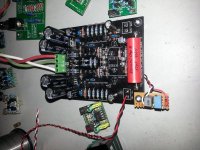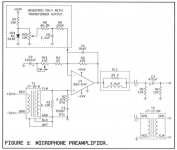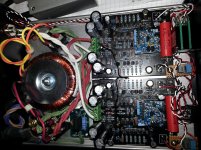Yes, it is. Mostly because the input impedance could never be matched. To match them, either the feedback R would need to get obnoxiously large, or the 47K would need to get obnoxiously small. - Bearing in mind the 47K forms a HPF with the input coupling cap. So if the 47k got really small, then the coupling cap would need to be proportionally larger and would end up being an electrolytic.
At the end of the day, its all about supplying a few uA into the input pins. and a few Mohm does that nicely on the + input
At the end of the day, its all about supplying a few uA into the input pins. and a few Mohm does that nicely on the + input
Yes, it is. Mostly because the input impedance could never be matched. To match them, either the feedback R would need to get obnoxiously large, or the 47K would need to get obnoxiously small. - Bearing in mind the 47K forms a HPF with the input coupling cap. So if the 47k got really small, then the coupling cap would need to be proportionally larger and would end up being an electrolytic.
The problem here is as a line input stage you want a high input impedance - which dictates a high value for the volume control - which dictates a high and variable output impedance feeding the opamp - which dictates that the noninverting terminal must be made into a high impedance node. It's not the coupling cap per se. (though its presence compounds the difficulties somewhat).
Then, either you make the inverting (feedback) node high impedance to match - and face high noise, poor stability - or you make it low - and face high DC output offset voltage, or the challenge of reducing or correcting the input offset currents.
However, Sparko's mod, while it probably degrades PSRR a little, seems to be a pretty acceptable way of getting around the problem as long as the variation in input current as the op amp module warms up are not too severe. Or Stan remembers to not plug in his headphones until several minutes after he turns on his amp!!
Last edited:
SS3601 op amp with trimmer; output offset vs time
That was my concern, too, whether it might hurt the 'phones. I just spent 45 minutes monitoring output offset voltage vs time. Ambient temperature 18 degrees C, no gain, no load. Output offset starts off momentarily at over -4 volts in the first inrush of current on power up; it falls to -2.2V in one or two seconds. After ten seconds, it's at -1.65V. It takes 20 minutes to drop below 100mV. After 40 minutes, it's in the -30 to +10mV range.
That was my concern, too, whether it might hurt the 'phones. I just spent 45 minutes monitoring output offset voltage vs time. Ambient temperature 18 degrees C, no gain, no load. Output offset starts off momentarily at over -4 volts in the first inrush of current on power up; it falls to -2.2V in one or two seconds. After ten seconds, it's at -1.65V. It takes 20 minutes to drop below 100mV. After 40 minutes, it's in the -30 to +10mV range.
... It's not how it sounds, but whether the output offset voltage is high enough in the warm-up interval to damage the headphones that's my principle worry.
That was my concern, too, whether it might hurt the 'phones. I just spent 45 minutes monitoring output offset voltage vs time. Ambient temperature 18 degrees C, no gain, no load. Output offset starts off momentarily at over -4 volts in the first inrush of current on power up; it falls to -2.2V in one or two seconds. After ten seconds, it's at -1.65V. It takes 20 minutes to drop below 100mV. After 40 minutes, it's in the -30 to +10mV range.
A plot of my offset voltage data is attached. First time I set the trimmers, it took an hour to stabilize - if indeed it was stable. 45 minutes of data is not enough to show it levelling off.
Attachments
OPA627 should work, OPA37 iffy. I don't recommend either, as they are not cost effective.
I think I don't understand this logic.
 There are at least two of us who might say that discrete op amps are worse than not cost-effective and are perhaps a waste of money altogether unless we can re-engineer the basic Sapphire circuit design, and who wants to do that? After all, it works so well even with a jelly bean op amp.
There are at least two of us who might say that discrete op amps are worse than not cost-effective and are perhaps a waste of money altogether unless we can re-engineer the basic Sapphire circuit design, and who wants to do that? After all, it works so well even with a jelly bean op amp.How many discrete op amps shall we try and at what cost? The circuit adjustments are beyond my ability for now, so I think I'm back to jelly beans.
Rather than buying SS3601 discretes, I should have bought OPA627's, which I'll probably do anyway. I like the sound of the discretes (Sparko SS3601), but it does look like they'll toast my headphones sooner or later on account of the barely tameable (in Sapphire, anyway) output offset. If I left the amp powered up (ie. never switch it off), it would be stable and sound fantastic and present no risk to my 'phones. But that's not practical for me.
I think I don't understand this logic.There are at least two of us who might say that discrete op amps are worse than not cost-effective and are perhaps a waste of money altogether unless we can re-engineer the basic Sapphire circuit design, and who wants to do that?
And what about FET-based DOA? Like this one [1]; input bias currents below 1nA level.
[1] http://www.sonicimagerylabs.com/pro.../995FET_Ticha_Docs/995FET_Ticha_Datasheet.pdf
In the context of ICs, there is no reason - none at all - that I can see to use a $30 OPA627 over a $3 OPA134.
The discrete module thing is something I opened up because people were interested in trying it. We learnt afterwards that many of these modules have high input currents, meaning they are not workable in the unmodified Sapphire circuit. Your options here are to choose a module with a workably low input current, and/or modify the Sapphire input circuit to a smaller or greater extent to reduce the effect of the input current.
I note the 990C has input bias current of 2.2 microV. Any module with a similar bipolar input stage is not going to work with the standard Sapphire config and the trick with the bias compensation resistor to V+ is far from ideal given the long settling times.
On the other hand, this might work nicely.
The discrete module thing is something I opened up because people were interested in trying it. We learnt afterwards that many of these modules have high input currents, meaning they are not workable in the unmodified Sapphire circuit. Your options here are to choose a module with a workably low input current, and/or modify the Sapphire input circuit to a smaller or greater extent to reduce the effect of the input current.
I note the 990C has input bias current of 2.2 microV. Any module with a similar bipolar input stage is not going to work with the standard Sapphire config and the trick with the bias compensation resistor to V+ is far from ideal given the long settling times.
On the other hand, this might work nicely.
With bias compensation.
If the following changes are made -
The bias compensation circuits is described as part of the traditional Microphone Preamp, Figure 1.
I tried the following opamps and it seems to work fine, they can be tuned to under 10 mv on the output, even under 1 mv, no warm up needed -
It does not work for Sparkos' SS3601. That sits at 200mv (stable) and seems to pop up to 2V on turn-off. Perhaps Sparkos could suggest why?
On turn-on, the meter didn't catch anything. On turn-off, they all acted the same - decayed, drifted up to 100 mv, then dropped down to -300 mv
and sat, even the opa134. Perhaps because there was no load or that I was using bench supplies to power them.
I still need to build the DIY-990 and SG-SOA-2...
Setup - just sitting on the bench, only one channel channel modified. The attached pot is a 10K TKD. Power provided by a couple of Kenwood bench supplies at +/- 15V. No load on the output. Sine and square waves look ok with the JE-918, the JLM-Hybrid rolls of the square wave, perhaps my setup or the 47pf that I added across R4.
Once the second channel is modified, it'll be the dreaded chassis drilling...
If the following changes are made -
- Add a 330uF 25V cap to bottom of R3/R3a - I used the SW1 pads.
- Add the simple bios compensation circuit from John Hardy's 990.pdf.
The bias compensation circuits is described as part of the traditional Microphone Preamp, Figure 1.
I tried the following opamps and it seems to work fine, they can be tuned to under 10 mv on the output, even under 1 mv, no warm up needed -
- JE-918
- DOA-17 (FiveFish)
- JLM-Hybrid (OPA2604, and the servo kicks in)
- OPA2134
- AD797
- SA5534A (though it's limited - 20 mv)
It does not work for Sparkos' SS3601. That sits at 200mv (stable) and seems to pop up to 2V on turn-off. Perhaps Sparkos could suggest why?
On turn-on, the meter didn't catch anything. On turn-off, they all acted the same - decayed, drifted up to 100 mv, then dropped down to -300 mv
and sat, even the opa134. Perhaps because there was no load or that I was using bench supplies to power them.
I still need to build the DIY-990 and SG-SOA-2...
Setup - just sitting on the bench, only one channel channel modified. The attached pot is a 10K TKD. Power provided by a couple of Kenwood bench supplies at +/- 15V. No load on the output. Sine and square waves look ok with the JE-918, the JLM-Hybrid rolls of the square wave, perhaps my setup or the 47pf that I added across R4.
Once the second channel is modified, it'll be the dreaded chassis drilling...
Attachments
Last edited:
Cool! Thanks so much for doing the hard work on this.
To confirm, the additional bias correction circuit is the part marked "required only with transformer output" in the attached figure?
I get from your results that everything but the SS3601 could be tamed by the input current cancellation circuit. By the way, a few hundred mV on turnoff is relatively common and I wouldn't see anything under 1-2 V as a problem. Likewise a stable operating offset of 50 mV or less is fine - there's no real reason to get terribly worried until its well above 100 mV.
To confirm, the additional bias correction circuit is the part marked "required only with transformer output" in the attached figure?
I get from your results that everything but the SS3601 could be tamed by the input current cancellation circuit. By the way, a few hundred mV on turnoff is relatively common and I wouldn't see anything under 1-2 V as a problem. Likewise a stable operating offset of 50 mV or less is fine - there's no real reason to get terribly worried until its well above 100 mV.
Attachments
Yes, that's the circuit I used.
The 10K trimmer is 25-turn. With it the OPA134 came down to under 1mV. The others, ignoring the SA5534, were around 3 or 4 mV.
FWIW - it'd be nice to use one of the 1000uF 25V caps from R3/R3a to ground, but that would require a 5mm lead spacing in the area of SW1.
The 10K trimmer is 25-turn. With it the OPA134 came down to under 1mV. The others, ignoring the SA5534, were around 3 or 4 mV.
FWIW - it'd be nice to use one of the 1000uF 25V caps from R3/R3a to ground, but that would require a 5mm lead spacing in the area of SW1.
Last edited:
Hmm interesting.
The fact is: I broked a pin changing the opa134 and I need a replacement but, instead buy a cheap OPA134, why not see a beter option? I don't see a problem if it is more expensive but with as litlle improvement...
So, OPA627 is a good option? (In china costs 5$ aprox)
Actually I use this discrete circuit, but with a 20k in R4 the volume goes down too much for the HD800.
What if use a 30k resistor in R4? Is too much?
http://i1359.photobucket.com/albums/q790/repente1/IMG_1212_zpsnbsjxifz.jpg
PD: Im trying new condensators!
http://i1359.photobucket.com/albums/q790/repente1/IMG_1187_zpsl0xxbwvr.jpg
Here is my original post (sorry, it's in spanish)
El hilo del "Sapphire amp" ( Funcionando :-D )
The fact is: I broked a pin changing the opa134 and I need a replacement but, instead buy a cheap OPA134, why not see a beter option? I don't see a problem if it is more expensive but with as litlle improvement...
So, OPA627 is a good option? (In china costs 5$ aprox)
Actually I use this discrete circuit, but with a 20k in R4 the volume goes down too much for the HD800.
What if use a 30k resistor in R4? Is too much?
http://i1359.photobucket.com/albums/q790/repente1/IMG_1212_zpsnbsjxifz.jpg
PD: Im trying new condensators!
http://i1359.photobucket.com/albums/q790/repente1/IMG_1187_zpsl0xxbwvr.jpg
Here is my original post (sorry, it's in spanish)
El hilo del "Sapphire amp" ( Funcionando :-D )
You can use 30k for R4. Or you can reduce R3. The gain is 1+R4/R3. Remember to check the output offset voltage to make sure it's not too high.
As I wrote above, the OPA627 is okay, but no reason to think it will sound any better than OPA134. For $5 though (you sure its genuine?) you might as well give it a try and see for yourself.
As I wrote above, the OPA627 is okay, but no reason to think it will sound any better than OPA134. For $5 though (you sure its genuine?) you might as well give it a try and see for yourself.
Yes, that's the circuit I used.
The 10K trimmer is 25-turn. With it the OPA134 came down to under 1mV. The others, ignoring the SA5534, were around 3 or 4 mV.
FWIW - it'd be nice to use one of the 1000uF 25V caps from R3/R3a to ground, but that would require a 5mm lead spacing in the area of SW1.
Do I understand correctly that you're not populating both R3 and R3a, but using one value in the R3a position with the 330uF cap between it and ground in the SW1 holes? And you'd like the cap to be more like 1000uF instead of 330uF.
Do I understand correctly that you're not populating both R3 and R3a, but using one value in the R3a position with the 330uF cap between it and ground in the SW1 holes? And you'd like the cap to be more like 1000uF instead of 330uF.
Correct. It's mostly academic as a 330 uF has a corner frequency of around 0.3 Hz with the current R3a of 1.5K. However, 330 uF is a bit of an odd value and a 1,000 uF would allow using the same caps as is already in the power supply while dropping the corner frequency down to 0.1 Hz.
(Assuming I did the calculations correctly.)
Last edited:
Completed the headphone amp this evening. Set it up using a pair of Sam Groner's SGA-SOA-2 opamps. Off set stabilized around 1 mv after adjustment.
Listening to it, even in the first hour the thing I most noticed was that the bass had more texture to it yet the notes were discrete. While there is harshness in the upper registers - cymbals don't ring due to it not being burned in, and it feels a bit constrained or tight, it's still quite nice overall. Vocals are more forward than I'm used to. The bass though, sometimes, just goes inside where I feel it.
FWIW Headphones are Senn HD-600, Stephan Audiomart Equinox headphone cable, a Schitt Modi 2 Uber DAC feeding it from uncompressed flac files.
Listening to it, even in the first hour the thing I most noticed was that the bass had more texture to it yet the notes were discrete. While there is harshness in the upper registers - cymbals don't ring due to it not being burned in, and it feels a bit constrained or tight, it's still quite nice overall. Vocals are more forward than I'm used to. The bass though, sometimes, just goes inside where I feel it.
FWIW Headphones are Senn HD-600, Stephan Audiomart Equinox headphone cable, a Schitt Modi 2 Uber DAC feeding it from uncompressed flac files.
Attachments
- Home
- Amplifiers
- Headphone Systems
- RJM Audio Sapphire Desktop Headphone Amplifier


